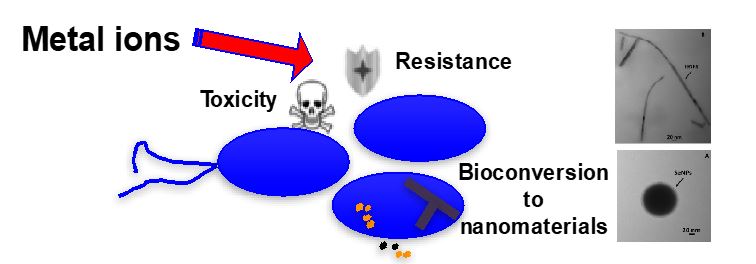Video Article Open Access
Using Bacteria to Manufacture Selenium and Tellurium Nanomaterials
Raymond J. Turner1*, Elena Piacenza1, Alessandro Presentato1, Greta Baggio2, Giovani Vallini2, Silvia Lampi2, Roberto Borghese3, Martina Cappelletti3, Davide Zannoni3
1Department of Biological Sciences, University of Calgary, Calgary, Canada
2Department of Biotechnology, University of Verona, Verona, Italy
3Department of Pharmacy and Biotechnology, University of Bologna, Bologna, Italy
Vid. Proc. Adv. Mater., Volume 2, Article ID 2021-0198 (2021)
DOI: 10.5185/vpoam.2021.0198
Publication Date (Web): 24 Feb 2021
Copyright © IAAM
Graphical Abstract

Abstract
The past 30 years has seen a shift from studying genes for metal resistance to understanding the relationship of metal ions to microbes with a more system biology appreciation. Understanding mechanisms of metal ion toxicity/resistance in bacteria is important for biomedical applications to metal pollutant bioremediation. Going beyond bioremediation of metals by biosorption to bioconversion can add value through the production of novel compounds. Although we have studied a wide range of elements, my interest has always returned to the oxyanions of Selenium and Tellurium that are bioavailable and toxic to most bacterial species. However, now several species have been isolated that are able to tolerate these oxyanions and convert them to the less toxic and less bioavailable elemental forms of Se0 and Te0 as precipitates are on the nanoscale [1]. Thus, the field has moved to see if such strains as able to bioconvert these toxic metalloids into nanomaterials, thus simultaneously having potential for bioremediation of chalcogen contaminated sites as well as being an eco-friendly alternative for the synthesis of Se and Te nanomaterials. My group, and in collaboration with others, have explored a number of different bacterial strains for their capacity to produce Se and Te nanomaterials including: Escherichia coli, Bacillus mycoides SelTE01, Stenotrophomonas maltophilia SelTE02, Rhodococcus aetherivorans BCP1, and Rhodobacter capsulatus. The nanomaterials that these strains produce are nanoparticles and nanorods of various sizes, dimensions, and crystalline structures. The physicochemical characteristics of the nanomaterial forms are dependent on a combination of the strain and different culturing conditions. In some cases, the nanomaterials are either secreted or produced extracellularly, for others the nanomaterials are found intracellularly. The Se and Te nanomaterials that are produced are remarkably stable [2], a feature of natural biochemicals as ‘capping’ agents from the microbes. This process is of interest for an approach of bioremediation of Se/Te contaminated environments through biosorption and conversion to a value-added product. The nanomaterials obtained to date have displayed promising electronic [3], fluorescent [4] and antimicrobial [5] properties. The work demonstrates the promise of using bacteria as eco-friendly bio-nanofactories to produced various metal(lloid) nanomaterials.
Keywords
Nanomaterial; Selenium, Tellurium, Bacteria.
Acknowledgement
R.J. Turner thanks the funding agency Natural Sciences and Engineering Research Council of Canada (NSERC).
References
- Piacenza, E., Presentato, A., Zonaro, E., Lampis, S., Vallini, G., Turner, R.J. Physical Science Reviews 2018, 3, 20170100.
- Piacenza, E., Presentato, A., Turner R.J. Critical Reviews Biotechnology. 2018, 38;,1137.
- Presentato, A., Piacenza, E., Darbandi, A., Anikovskiy, M. Cappelletti, M. Zannoni, D., Turner, R.J. 2018, Scientific Reports 8, 3923.
- Piacenza, E., Presentato, A., Heyne, B., Turner, R.J. Nanophotonics. 2020, 10.1515/nanoph-2020-0239.
- Piacenza, E. Presentato, A., Zonaro E., Lemire J., Demeter, M., Vallini, G., Turner, R.J., Lampis, S. 2017, Microbial Biotechnology 10, 804.
Biography
Raymond J. Turner is a multi-ethnic multi-generational Canadian. Academic career began with a B.Sc. (1985) in Biochemistry / Chemistry followed by a Ph.D. (1990) in Physical Biochemistry at the University of Calgary Canada. Post-Doctoral training (1990-1994) was obtained in Molecular and Microbial Biochemistry at University of Alberta, Canada. In January 1998, he was recruited to the University of Calgary. The position was promoted to Associate Professor in 2001 with tenure on July 2002. Promotion to full professor of Biochemistry and Microbiology in 2007 and is presently appointed as Faculty Professor of Science. He has held the post as Associate Department Head and Graduate program director from 2013-2017. He has also served on Dean’s and vice-presidents’ advisory committees. He was also chair of various research cluster units between 2006 and 2013. He has held funding from the Canadian funding councils of NSERC, CIHR, Genome Canada, and MITACS as well as a number of industrial partners. He has received awards of excellence in research and excellence in graduate student supervision from the University of Calgary. He has also received visiting professorship appointments from the University of East Anglia, England, University of Bologna and University of Verona, Italy, as well as receiving a number of Fellowships from the Instituto di Studi Avanzati, Italy. He was also awarded the Western Universities Speaker Lectureship from the Canadian society of Chemistry in 2015. He has contributed >250 publications over these areas and holds 8 patents/licences. His h-index is presently 44 (Scopius) or 52 (google scholar) with more > 11,500 citations. He has seen 47 graduate students and 22 PDF’s, and 20 research associates/technicians through his Microbial Biochemistry Laboratory. Research interests are multi-disciplinary from metal toxicity/sensitivity and resistance/tolerance mechanisms in bacteria, to Biofilm physiology and biochemistry, to protein transporters and translocases.
Video Proceedings of Advanced Materials

Upcoming Congress



